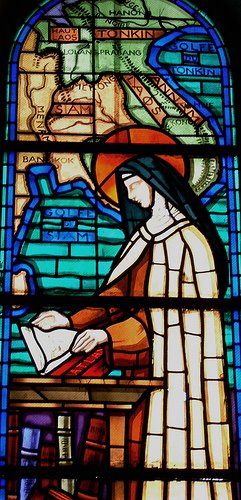"The Science of Divine Love" - Apostolic Letter Declaring St. Therese a Doctor of the Church - Day One - October 11, 2017
 St. Therese with the map of Asia
St. Therese with the map of Asia
DIVINI AMORIS SCIENTIA
Apostolic Letter of Pope John Paul II
Proclaiming St. Therese a Doctor of the Church
October 19, 1997
To prepare for the 20th anniversary of Therese's doctorate on October 19, in nine days of preparation let's meditate on a different section of the Apostolic Letter each day.
1. THE SCIENCE OF DIVINE LOVE, which the Father of mercies pours out through Jesus Christ in the Holy Spirit, is a gift granted to the little and the humble so that they may know and proclaim the secrets of the kingdom, hidden from the learned and the wise; for this reason Jesus rejoiced in the Holy Spirit, praising the Father who graciously willed it so (cf. Lk 10:21-22; Mt 11:25-26).
Mother Church also rejoices in noting that throughout history the Lord has continued to reveal himself to the little and the humble, enabling his chosen ones, through the Spirit who "searches everything, even the depths of God" (1 Cor 2:10), to speak of the gifts "bestowed on us by God... in words not taught by human wisdom but taught by the Spirit, interpreting spiritual truths in spiritual language" (1 Cor 2:12,13). In this way the Holy Spirit guides the Church into the whole truth, endowing her with various gifts, adorning her with his fruits, rejuvenating her with the power of the Gospel and enabling her to discern the signs of the times in order to respond ever more fully to the will of God (cf, Lumen gentium, nn. 4, 12; Gaudium et spes, n. 4).
Shining brightly among the little ones to whom the secrets of the kingdom were revealed in a most special way is Therese of the Child Jesus and the Holy Face, a professed nun of the Order of Discalced Carmelites, the 100th anniversary of whose entry into the heavenly homeland occurs this year.
During her life Therese discovered "new lights, hidden and mysterious meanings" (Ms A, 83v) and received from the divine Teacher that "science of love" which she then expressed with particular originality in her writings (cf. Ms B, 1r). This science is the luminous expression of her knowledge of the mystery of the kingdom and of her personal experience of grace. It can be considered a special charism of Gospel wisdom which Therese, like other saints and teachers of faith, attained in prayer (cf. Ms C, 36r).
2. The reception given to the example of her life and Gospel teaching in our century was quick, universal and constant. As if in imitation of her precocious spiritual maturity, her holiness was recognized by the Church in the space of a few years. In fact, on 10 June 1914 Pius X signed the decree introducing her cause of beatification; on 14 August 1921 Benedict XV declared the heroic virtues of the Servant of God, giving an address for the occasion on the way of spiritual childhood; and Pius XI proclaimed her blessed on 29 April 1923. Shortly afterwards, on 17 May 1925, the same Pope canonized her before an immense crowd in St Peter's Basilica, highlighting the splendor of her virtues and the originality of her doctrine. Two years later, on 14 December 1927, in response to the petition of many missionary Bishops, he proclaimed her patron of the missions along with St. Francis Xavier.
Beginning with these acts of recognition, the spiritual radiance of Therese of the Child Jesus increased in the Church and spread throughout the world. Many institutes of consecrated life and ecclesial movements, especially in the young Churches, chose her as their patron and teacher, taking their inspiration from her spiritual doctrine. Her message, often summarized in the so-called "little way", which is nothing other that the Gospel way of holiness for all, was studied by theologians and experts in spirituality. Cathedrals, basilicas, shrines and churches throughout the world were built and dedicated to the Lord under the patronage of the Saint of Lisieux. The Catholic Church venerates her in the various Eastern and Western rites. Many of the faithful have been able to experience the power of her intercession. Many of those called to the priestly ministry or the consecrated life, especially in the missions and cloister, attribute the divine grace of their vocation to her intercession and example.
Reader Comments